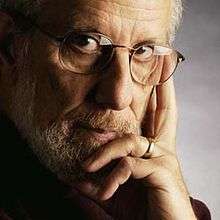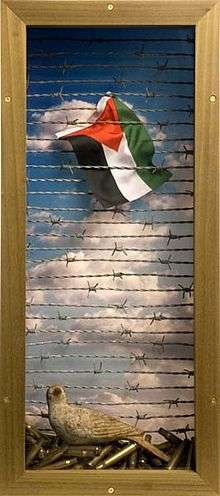Roger Cook (graphic designer)
Roger Cook (born Rajie Cook, 1930) is an American graphic designer, photographer and artist.

He was president of Cook and Shanosky Associates, a graphic design firm he founded in 1967. The firm produced all forms of corporate communications including: Corporate Identity, Advertising, Signage, Annual Reports and Brochures.
His graphic design and photography have been used by IBM, Container Corporation of America, Montgomery Ward, Bristol Myers Squibb, Black & Decker, Volvo, Subaru, AT&T, New York Times, Bell Atlantic, BASF, Lenox, and a number of other major international corporations.
He received the Presidential Award for Design Excellence from president Ronald Reagan and Elizabeth Dole on January 30, 1984 in the Indian Treaty Room of the Old Executive Office Building in Washington, DC. Juries under the auspices of the National Endowments chose the thirteen winners of the Federal Design Achievement Awards for the Arts.

In 2003, Symbols Signs a project designed by his firm for the US Department of Transportation was accepted by the Acquisitions Committee to the collections of Cooper-Hewitt, National Design Museum, and The Smithsonian Institution.
Cook is a graduate of the Pratt Institute and in 1997 was selected as Alumni of the year, and has also served on the Pratt Advisory Board. He has been a member of the American Institute of Graphic Arts.
Sculptural assemblages

Inspired in part by the work of Joseph Cornell, Cook has turned to sculptural assemblage.
In 1999, after 46 years as a graphic designer, I found time to explore this new medium, sculptural "assemblage". The inspiration and opportunity to explore this mode of artistic expression comes at a time when my commercial career has sufficiently matured so that I can apply my skills, experiences, and a lifetime of artistic perspective to create "statements" with these assemblages. Most of my "raw" materials come from private collections, my own photography, flea markets, and antique shops, where I spend hours searching for items that inspire use in my boxes. My process, using these "found" materials, feels to me much like theater. As in the legitimate stage, I work within a three-dimensional form to portray the comedy or tragedy of life. I create these miniature, silent, "theaters" to express my feelings about a range of subjects. The three-dimensional objects I construct, using the found and fabricated objects (my "Thespians"), are a series of "performances" that share my deepest feelings with my audience.
Many of the “Boxes” that he has created are an expression of the artist’s deeply felt concern for human rights and for the tragic conditions in the Middle East. They were created to articulate the circumstances and experiences he encountered during the ten years he has served on the Task Force for the Middle East, a group sponsored by the Presbyterian Church, USA. With this group he has traveled on fact-finding trips to Israel, Jordan, and Palestine (West Bank and Gaza).
External links
- Roger's Website featuring more of his box assemblies.
- DOT pictograms (symbol signs)
- Airport, an animated film made from AIGA pictograms